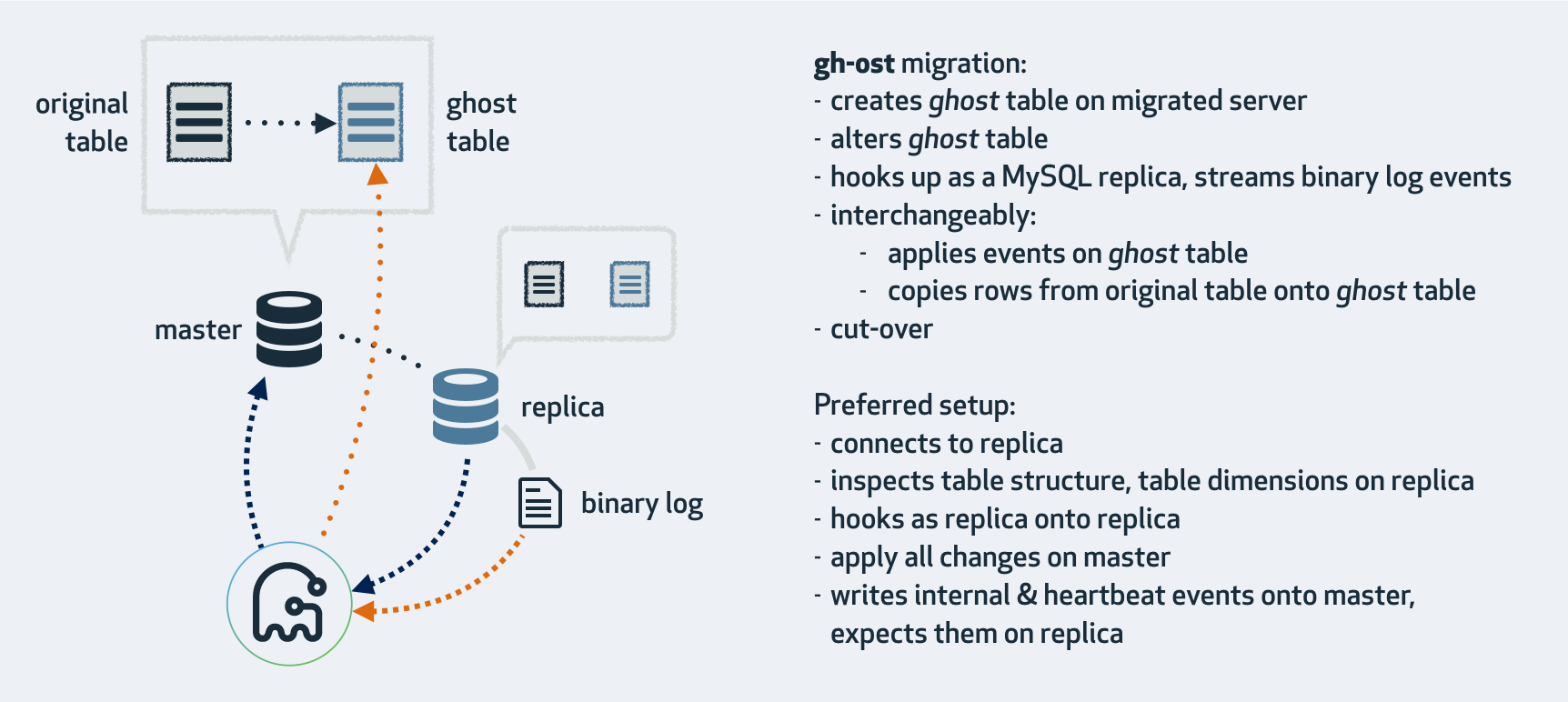gh-ost is a triggerless online schema migration solution for MySQL. It is testable and provides pausability, dynamic control/reconfiguration, auditing, and many operational perks.
gh-ost produces a light workload on the master throughout the migration, decoupled from the existing workload on the migrated table.
It has been designed based on years of experience with existing solutions, and changes the paradigm of table migrations.
All existing online-schema-change tools operate in similar manner: they create a ghost table in the likeness of your original table, migrate that table while empty, slowly and incrementally copy data from your original table to the ghost table, meanwhile propagating ongoing changes (any INSERT, DELETE, UPDATE applied to your table) to the ghost table. Finally, at the right time, they replace your original table with the ghost table.
gh-ost uses the same pattern. However it differs from all existing tools by not using triggers. We have recognized the triggers to be the source of many limitations and risks.
Instead, gh-ost uses the binary log stream to capture table changes, and asynchronously applies them onto the ghost table. gh-ost takes upon itself some tasks that other tools leave for the database to perform. As result, gh-ost has greater control over the migration process; can truly suspend it; can truly decouple the migration's write load from the master's workload.
In addition, it offers many operational perks that make it safer, trustworthy and fun to use.
- Build your trust in
gh-ostby testing it on replicas.gh-ostwill issue same flow as it would have on the master, to migrate a table on a replica, without actually replacing the original table, leaving the replica with two tables you can then compare and satisfy yourself that the tool operates correctly. This is how we continuously testgh-ostin production. - True pause: when
gh-ostthrottles, it truly ceases writes on master: no row copies and no ongoing events processing. By throttling, you return your master to its original workload - Dynamic control: you can interactively reconfigure
gh-ost, even as migration still runs. You may forcibly initiate throttling. - Auditing: you may query
gh-ostfor status.gh-ostlistens on unix socket or TCP. - Control over cut-over phase:
gh-ostcan be instructed to postpone what is probably the most critical step: the swap of tables, until such time that you're comfortably available. No need to worry about ETA being outside office hours. - External hooks can couple
gh-ostwith your particular environment.
Please refer to the docs for more information. No, really, read the docs.
The cheatsheet has it all. You may be interested in invoking gh-ost in various modes:
- a noop migration (merely testing that the migration is valid and good to go)
- a real migration, utilizing a replica (the migration runs on the master;
gh-ostfigures out identities of servers involved. Required mode if your master uses Statement Based Replication) - a real migration, run directly on the master (but
gh-ostprefers the former) - a real migration on a replica (master untouched)
- a test migration on a replica, the way for you to build trust with
gh-ost's operation.
Our tips:
-
Testing above all, try out
--test-on-replicafirst few times. Better yet, make it continuous. We have multiple replicas where we iterate our entire fleet of production tables, migrating them one by one, checksumming the results, verifying migration is good. - For each master migration, first issue a noop
- Then issue the real thing via
--execute.
More tips:
- Use
--exact-rowcountfor accurate progress indication - Use
--postpone-cut-over-flag-fileto gain control over cut-over timing - Get familiar with the interactive commands
Also see:
- requirements and limitations
- common questions
- what if?
- the fine print
- Community questions
- Using
gh-oston AWS RDS - Using
gh-oston Azure Database for MySQL
Originally this was named gh-osc: GitHub Online Schema Change, in the likes of Facebook online schema change and pt-online-schema-change.
But then a rare genetic mutation happened, and the c transformed into t. And that sent us down the path of trying to figure out a new acronym. gh-ost (pronounce: Ghost), stands for GitHub's Online Schema Transmogrifier/Translator/Transformer/Transfigurator
gh-ost is licensed under the MIT license
gh-ost uses 3rd party libraries, each with their own license. These are found here.
gh-ost is released at a stable state, but with mileage to go. We are open to pull requests. Please first discuss your intentions via Issues.
We develop gh-ost at GitHub and for the community. We may have different priorities than others. From time to time we may suggest a contribution that is not on our immediate roadmap but which may appeal to others.
Please see Coding gh-ost for a guide to getting started developing with gh-ost.
gh-ost is now GA and stable.
gh-ost is available in binary format for Linux and Mac OS/X
gh-ost is a Go project; it is built with Go 1.15 and above. To build on your own, use either:
-
script/build - this is the same build script used by CI hence the authoritative; artifact is
./bin/gh-ostbinary. -
build.sh for building
tar.gzartifacts in/tmp/gh-ost-release
Generally speaking, master branch is stable, but only releases are to be used in production.
gh-ost is designed, authored, reviewed and tested by the database infrastructure team at GitHub:



